Beer Spas, Nude Hot Springs, Forest Lodges and Other Wonders of an Oregon Road Trip
It is surprisingly easy, I discovered, to chat with strangers in the nude. It was a typically gray morning at Breitenbush Hot Springs, in a valley in the Oregon Cascades south of Mount Hood-a perfect time to sit outside among the juniper and ponderosa pines in a geothermal stone pool the same temperature as a bath. I had arrived the day before and had already eaten tempeh for two consecutive meals and gotten a massage. There was little else to do: neither Wi-Fi nor cell service could be found for miles.
As I soaked, I bonded with a woman over the fact that we were both single, but we never managed to trade names. She said she lived in Bend, a couple of hours away. I told her I'd never been, but was on a road trip and was headed out there in a few days. "It has a unique culture from the rest of Oregon," she said, floating on her back. "There are plastic-surgery places and Porsches everywhere. A lot of Californians have second homes there. I'm from California originally."
Related: Where to Find the World's Longest Road
"I am, too," I said. Just after my 18th birthday, I moved to Portland to attend Reed College, where I was always too busy procuring beer, chasing boys, and reading French poets to get around to visiting the rest of Oregon. When I'd started my trip a few days earlier, I'd seen how much Portland had changed over the years. Where once there were desolate blocks occasionally interrupted by one of the strip clubs the city is famous for, now there were gleaming glass condo high-rises and natural-wine bars and marijuana dispensaries that resembled Apple stores. On my way into town from the airport, on a single block I saw a hotel made up of individual tiny houses (the latest manifestation of the tiny-house movement) and a black Rolls-Royce Phantom. Portland, which once felt like a sprawling small town largely forgotten by the rest of the country, is now fully upscale, a lifestyle mecca. It's a city that feels at once precious and slick.
My friend Stewart calls this "New Oregon," a kind of Oregon that exists in dramatic contrast to the down-home libertarianism of many of the state's more rural areas. Stewart also went to Reed, although not at the same time as I did, and we both share a deep affection and nostalgia for the Pacific Northwest. When Portlandia premiered, we watched the first few episodes together in Brooklyn. I had brought him along on this trip to explore the changes percolating through the state (and to drive me around-I don't know how).
As we would soon discover, New Oregon has been seeping beyond Portland: first it made its way into the Willamette Valley, the wine-growing region south of the city; now it has reached Central Oregon, the heavily wooded part of the state between the Cascades and the Ochoco Mountains. The spread of this ethos is the inevitable result of the influx of newly minted Oregonians who have moved to Portland because it's relatively affordable or safe or beautiful or just hip. Now they're ready to explore the state, and many businesses have begun catering to these weekenders. But sometimes they push up against people who have been living in these places for a long time. When I was in college, someone once said with pride that people from Central Oregon were America's equivalent of the kids who sit at the back of the class. For decades, they seemed not just content to be ignored but to prefer it. There has long been a certain frontier spirit in this part of the state, a self-sufficiency represented by hippie landowners, do-it-yourself winemakers, rugged outdoor types, and remote ranchers. New Oregonians are drawn to that same pioneering spirit, but by their very presence, they're also changing it.
Newberg, a town in the Willamette Valley about 45 minutes southwest of Portland, Stewart and I went to Wolves & People, a brewery started last year by Christian DeBenedetti, who is tall and soft-spoken, with an easygoing charisma. He was raised on nearby Springbrook Hazelnut Farm, among the orchards. (Even the hazelnut, once known as the humble filbert, has undergone a makeover. "There's a saying around here," DeBenedetti said. " We grow filberts, but we sell hazelnuts.' ") He started home-brewing in his college dorm, won a Watson Fellowship to study beer in Europe and West Africa, and then moved to New York and worked as a magazine writer. In 2011, he moved back to the Willamette Valley, intent on starting his own brewery. His most talked-about beer is called Instinctive Travels and is named in honor of the late Phife Dawg, of the hip-hop group A Tribe Called Quest. Made with a variety of unexpected yeasts, some exotic, it is lighter and less bitter than the hops-heavy beers I associate with craft breweries. DeBenedetti doesn't have that bearded, I'm-a-part-time-blacksmith look I associate with craft brewers, either.
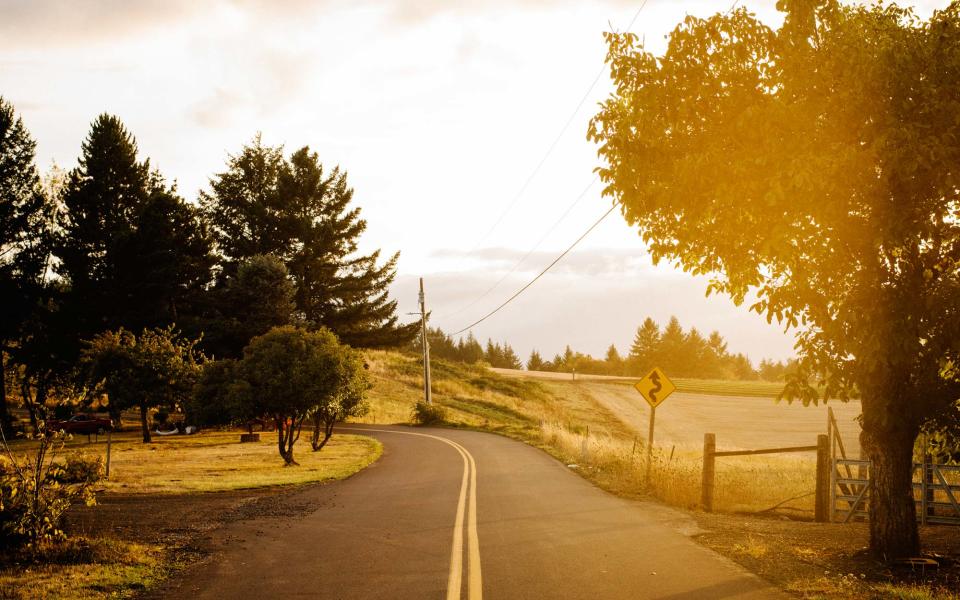
What the Willamette Valley is best known for, however, is reliably excellent Pinot Noirs. The 45th Parallel (halfway between the equator and the North Pole) runs right through the valley, and if you followed it far enough, you'd end up in southern France. One of the best vineyards we visited, Anne Amie, in the town of Carlton, sits about 20 miles north of the 45th. "There's a perfect bell curve of precipitation, and really long days in summer," said Thomas Houseman, the winemaker at Anne Amie.
In the 1960s and '70s, adventurous vintners, many from California, began planting grapes in the Willamette. The region started taking off in the 80s, before exploding this past decade. Now it's common to see Willamette Valley Pinots on wine lists all over the world-a few weeks earlier, I had ordered one at a bar in Copenhagen-but the region still feels intimate and a little scrappy. The tasting rooms lack the ash of their Napa peers. Many of the youngish vintners are early in their lives' second acts, like Houseman, who used to be a modern dancer, and John Grochau of Grochau Cellars, a former competitive cyclist.
Anne Amie has a very French-country look, with a tasting room overlooking rows of grape vines. It is owned by Robert B. Pamplin Jr., a multimillionaire businessman in Portland who "lets us do whatever we want," Houseman told me. By this he meant that, in addition to the famous Pinots, Anne Amie can make more unconventional and time-intensive products, including a sparkling wine and dessert wines made with Mller-Thurgau grapes, some planted as long ago as 1979. He poured us a taste of the winery's Two Estates Pinot Noir, a blend of the best vintages from its two vineyards, Twelve Oaks Estate and Anne Amie Estate. It was elegant, slightly acidic, ripe.
"The Willamette Valley is in a transition period," Houseman said. "It's still a romantic wine region where you rub shoulders with makers and proprietors, but it's also becoming more upscale." As evidence of the latter, he pointed to the eight-year-old Allison Inn & Spa, which has a private art collection and a restaurant with live piano music-classically fancy. We stayed instead at a property clearly designed to cater to New Oregonians: the Vintages, a resort made up of classic trailers that opened in 2014 in Dayton (population 2,500), where the accommodations come equipped with L'Occitane bath products and locally roasted Caravan Coffee, with nine-step instructions for making the perfect pour-over ("wait 30 seconds as the coffee blooms"). The property has a little market on site that sells the Vintages' own blend of Pinot. It also offers a "You Had Me at Pinot" package that includes wine and tasting-room passes.
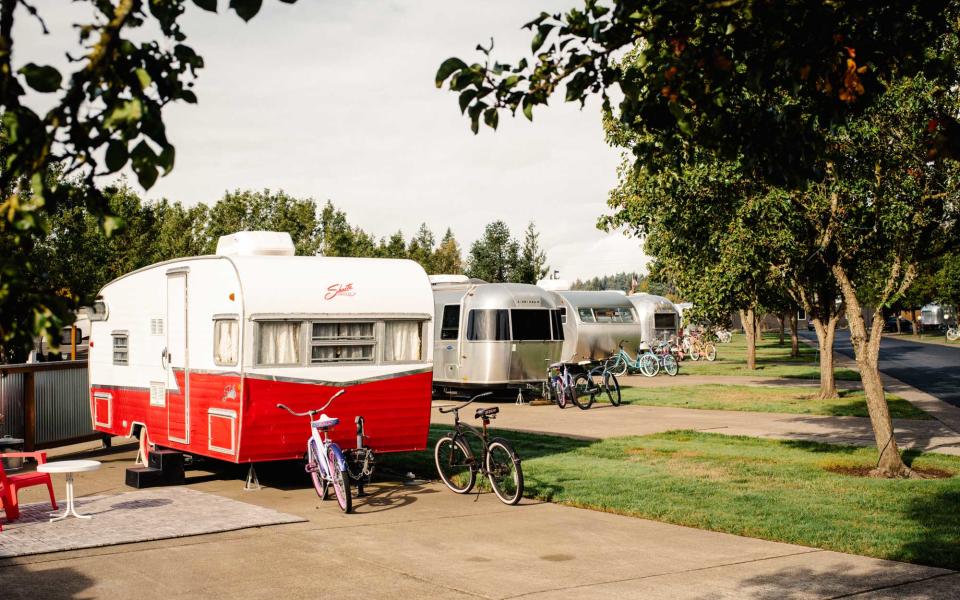
"This is the first time I have understood the allure of staying in a trailer hotel," Stewart told me. His 1963 Silver Streak Duchess had Scandinavian minimalist dcor, all blond wood. My 2015 Flyte Camp Neutron had a Japanese soaking tub. I poured in some THC-infused organic bath soak I had bought at a dispensary in Portland and sat there for a long time before dinner, snacking on lightly salted hazelnuts from DeBenedetti's farm and listening to the rain drumming on the windows.
The next morning Stewart and I texted each other from our trailers even though they were about 10 feet apart. "Do you have the printed-out directions?" he asked. We planned to drive from the valley into the wooded foothills of the Cascades, where we would continue our explorations with an evening of holistic healing and quiet contemplation in the pools of Breitenbush, about 90 minutes away. Stewart put on a painstakingly compiled playlist full of obscure Beach Boys songs as we drove east through the Dundee Hills, finding ourselves on a mostly unpaved back road surrounded by rows of vineyards and the occasional farmhouse. "We're heading into the forest," Stewart said. Our cell phones quickly became useless.
Breitenbush is a bit of an anomaly in Central Oregon: a resolutely off-the-grid relic beloved by both old hippies and millennial bobos looking to unwind. It has bare-bones cabins and a dining hall with a vegetarian menu heavy on whole grains. While eating there, I overheard a man reading from his journal about the "sacred feminine" to a fellow member of a retreat. Breitenbush also offers the kinds of in-vogue detoxes (from rich food, technology, crowds) that one could find in a high-end spa, but at decidedly more affordable prices. The place is run by a worker-owned co-op that adheres to a "low-growth" philosophy, which I asked Peter Moore, the business director, to explain to me.
"We are aware that we could definitely raise rates," he said. "And we could build five-star cabins. However, we are actively downward-mobile. We are not competing with other high-income places with manis and pedis. You get what you get- comfort in deep nature."
"Deep nature" turned out to be better than any mani or pedi I have ever had. Late at night Stewart and I made our way through the dark to the silent pool, the hottest of the hot springs, on the edge of a meadow where there was nothing but steam coming off the water to distract us from the stars and trees and mountains in the distance.
The next day, with some reluctance, we left our hot-springs haven and drove one hour to the Suttle Lodge & Boathouse, a rustic inn in Deschutes National Forest that signals New Oregon's unambiguous arrival in this part of the state. Last year, a group of hospitality all-stars, led by the Mighty Union, the group behind the Ace Hotel Portland, opened it on the former site of the Lodge at Suttle Lake. Situated on about 15 acres, with a big, bucolic lake, it is meant to be a year-round destination, with canoeing and fly-fishing in the summer and skiing and snowshoeing in the winter.
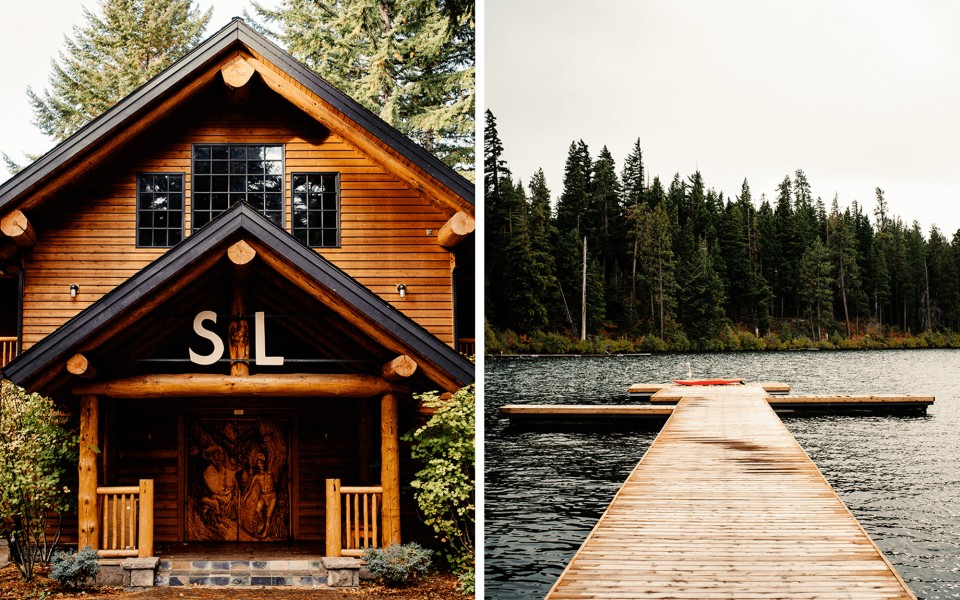
"It's not Look at how fancy this room is,' but Look at this beautiful lake,' " said Karly Drake-Lusby, the front-desk clerk, who showed us to our room. It had a Jacuzzi tub and a replace and a few pieces of custom furniture for lounging that were an indescribable hybrid of beanbag, couch, and chair (and so addictively comfortable that the Mighty Union plans to start selling them online). The room was cozy, but it was true that the large windows looking onto fir trees and Suttle Lake were its highlight.
We entered the lodge through elaborately carved wooden doors with reliefs of a Native American ceremony featuring a dancer in a headdress. Inside, we found a great room with shelves of well-curated books (Edward St. Aubyn, Tom Robbins) and vinyl records (Patsy Cline, the original Alfie soundtrack). The atmosphere was a little bit Moonrise Kingdom, with some Wet Hot American Summer and a dash of Portlandia. In the morning, a poodle and a beagle roamed as guests made their way into the main room in flannel pajamas and slippers and expensive down jackets. Some drank coffee and stared at the lake, while others read or sketched by the fire. A few groups went to the nearby restaurant, the Boathouse, for egg sandwiches. "That kid is dressed just like Paddington Bear," I said to Stewart, who corrected me: "No, I think his look is longshoreman."
Theres always been a certain frontier spirit to this part of the state.
At night, the main room looked a bit like an upscale, West Coast version of the cantina scene in Star Wars. We found guys with man buns talking about Harmony Korine while parents clad in cashmere challenged their adolescent children to chess matches and a trio of thirtysomething blondes played cards. Maybe it was curiosity after a day of observing one another around the lodge, or maybe it was the negronis and mezcal cocktails, but suddenly everyone started chatting-one big party in the woods. I left to get something from our room and returned to find a guest showing Stewart photos of a failed planned community outside of Bend called the Shire, inspired by the hobbit world of J.R.R. Tolkien.
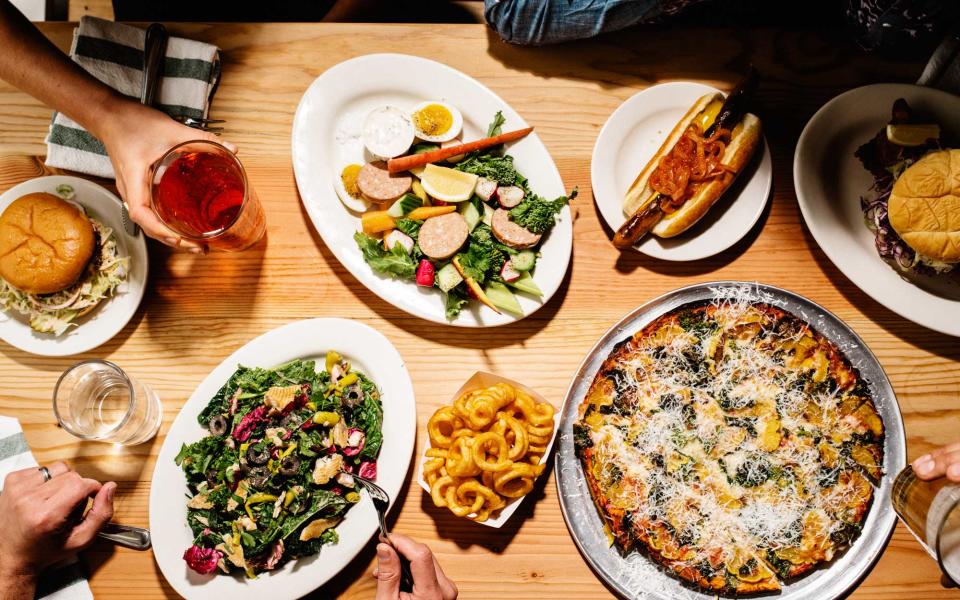
Stewart and I ordered cracker-crust pizza with kale and pepperoni from Skip, the cocktail lounge in the lodge. The Skip and Boathouse menus were created by Joshua McFadden, a veteran of the celebrated Brooklyn pizzeria Franny's who is now the chef at Ava Gene's, one of Portland's most popular farm-to-table restaurants. As we ate, we chatted with Donald Kenney, a co-owner of the Suttle Lodge and the general manager of the Ace. Guests in Portland, he told us, always ask, "What should I do outside the city?" He pulled out his phone to show us pictures of Cowboy Dinner Tree Restaurant, in Silver Lake, 100 miles to the south, where he'd gone to dinner earlier. It sells only two entres: a 26-ounce top sirloin steak and a whole roasted chicken, both of which must be ordered ahead, with absolutely no sharing allowed, for $30 a head. I begged Stewart to go, but his willingness to chauffeur me around the state had its limits.
Later, a crew we'd met in the great room invited us to go into Bend to see a show by the Boise-based indie-rock band Built to Spill. I wanted to do it all: go deeper into rural Oregon to dine on supersize cowboy fare and go into a mountain-sports town to see one of my favorite scruffy rock bands play at a tiny club. It was the push and pull of the new and the old, and in Central Oregon you can have both. At least in theory: Stewart and I decided we were enjoying ourselves too much at the lodge to leave its cozy confines.
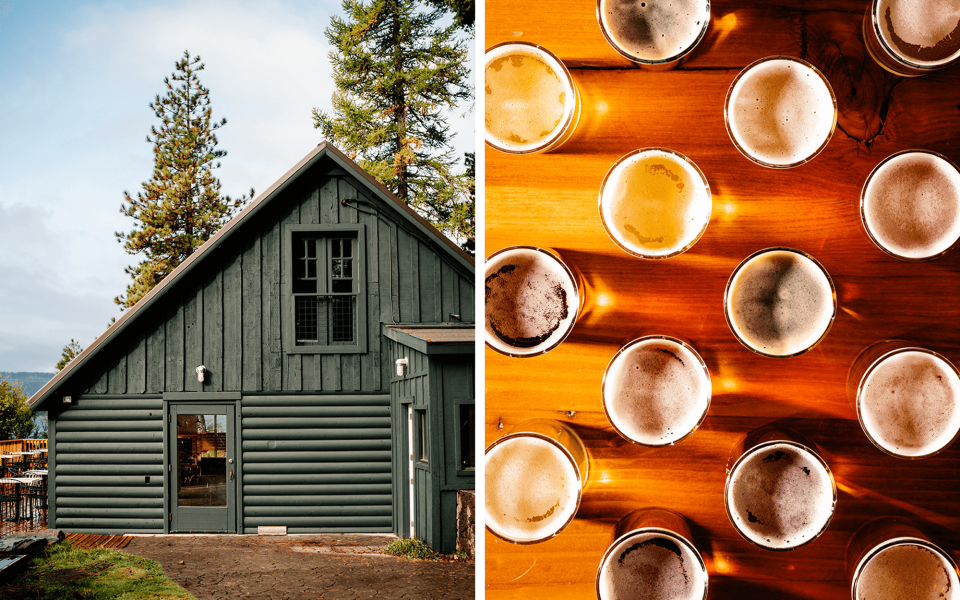
The closest municipality to Suttle Lodge is Sisters, a relentlessly charming country-and-western town. We stopped at a thrift store that had a wall of cowboy hats and a $16 shearling coat I tried to persuade Stewart to buy. In another country-themed thrift store-yes, there's more than one-I almost talked myself into purchasing an antique Native American silver-and-turquoise squash-blossom necklace, but the price tag was about half my rent. In an alpaca-goods store on the main strip, a man sat in the back, knitting. Everyone we met told us to come back in the summer for the annual rodeo and the world's largest outdoor quilt show.
While Sisters looked like it could be a setting for a movie about the Wild West, we stumbled upon unexpected touches of West Coast boho chic there. At Sisters Coffee Co., Fleetwood Mac played on the stereo, and the shortbread was flavored with Earl Grey. After a snack, we headed to Hop in the Spa, America's first beer-centric spa, which opened just over a year ago. I had pictured it like Willy Wonka's factory but with a river of beer instead of chocolate. Instead, the staff takes locally brewed Deschutes beer, renders it into a solid, then grinds it into a kind of bath soak. We were shown into a room with potted plants, tiny white lights, and two wooden tubs. Each was filled with the sweet, yeasty-smelling bath brew, 150 hops flowers, and slices of lemon, which made it feel sort of like bathing in a giant, warm Hefeweizen.
Afterward, we got a couples massage (it was all they had available) with two masseuses working our muscles with hops oil. I had warned Stewart that this trip was going to involve being naked around me, and he was a good sport, but the implied romance of the couples massage did feel a bit awkward. "Would you do this again?" Stewart asked. "I don't know that I need to do this again."
"Are you talking about the massage or the sticky beer bath?" I replied.
"Both," he said.

After leaving Hop in the Spa, we became obsessed with a place called Drawstrings of Malibu that sells very un-Oregon-style owy cotton clothes. A plaque on the front helpfully informed us that the line was launched in Malibu in the late 70s. Some ofthe clothes looked accidentally cool, like they could be sold at Opening Ceremony. Here Stewart did end up buying two shirts. "Drawstrings of Malibu," we kept whispering to each other in the car and giggling.
We spent the night at Tetherow, a resort on the outskirts of Bend where the rooms all have big mudrooms for your outdoor gear. From our view over the golf course, we could see middle-aged men riding single-person contraptions that looked like hoverboards crossed with scooters, instead of golf carts. Later I learned their name: Golf Boards. Vacation homes at Tetherow sell for the high six figures, and though I didn't see any of the Porsches or plastic-surgery clinics my naked friend at Breitenbush had told me about while we were in Bend, I did pick up a sense of unrepentant capitalism among all the rugged outdoor types. The latest beer at the craft brewery the Crux Fermentation Project was called Gimme Mo.
At the end of the week, we took the long way back to Portland. Stewart navigated Bend's outskirts, driving past alpaca farms and livestock-auction houses, until we reached Smith Rock State Park, thought to be named after a soldier who fell to his death there during a battle with the Northern Paiute in 1863. We walked a dirt trail along the top of a canyon that overlooked a narrow river. Surrounding us on three sides were the park's rocks, which were intimidatingly tall and steep and colored in shades of deep rust and terra-cotta.
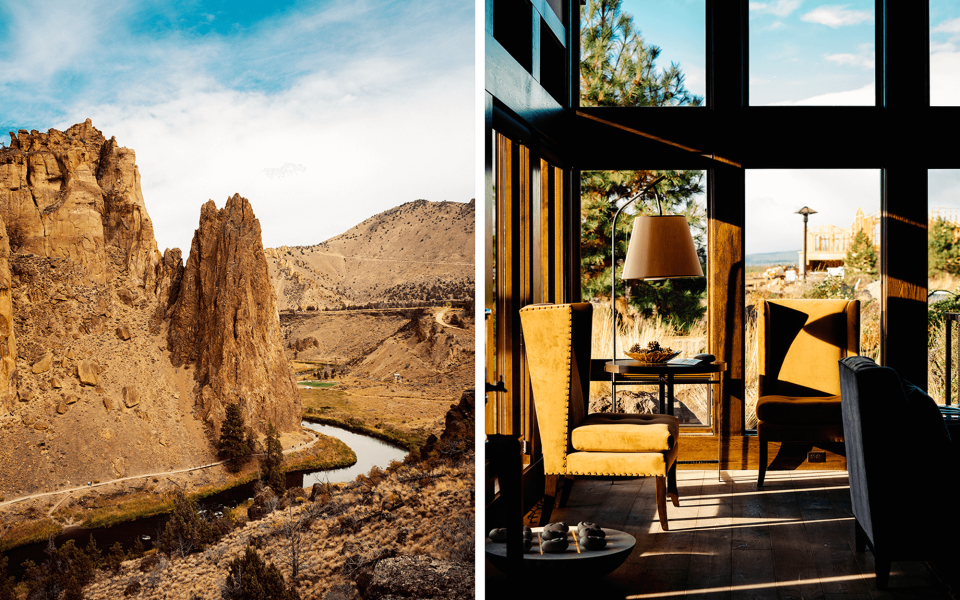
As we got closer, we realized that what had looked like specks on the rocks were actually dozens of people climbing, on a Monday afternoon, trying to reach the top. In an odd way, the scene felt like it encapsulated the whole trip. New Oregon or old, this has always been a part of the country where people have come to climb and reach, on their own terms, whenever and wherever they want.

The Details: What to Do in the Willamette Valley and Central Oregon
Hotels
Breitenbush Hot Springs: Rustic cabins in the Cascade Mountains for nature-loving travelers who want 24/7 access to the area’s springs. breitenbush.com; doubles from $102.
Suttle Lodge & Boathouse: This lakeside lodge, from the team behind the Ace Hotel Portland, is in Deschutes National Forest and has a lovely restaurant serving elevated breakfast fare and trout chowder. thesuttlelodge.com; doubles from $195.
Tetherow: A modern lodge and golf course sitting on 700 acres in Bend with easy access to the nearby mountains. tetherow.com; doubles from $179.
The Vintages: Refurbished classic trailers with dcor styles ranging from retro American to Scandi-minimalist. Dayton; the-vintages.com; doubles from $95.
Restaurants and Bars
Crux Fermentation Project: There are so many breweries in Bend that it has its own Ale Trail. This one, often recommended by locals, uses a variety of nontraditional brewing methods like decoction mashing, open fermentation, and barrel aging. cruxfermentation.com.
Nick’s Italian Caf: Choose from a variety of pizzas and pasta dishes at this wine-country Italian place where the locals hang out in the back room. McMinnville; nicks-italiancafe.com; entres $8$18.
Wolves & People: This Willamette Valley brewery on a hazelnut farm crafts saisons, stouts, and ales, many of which are inspired by Belgian seasonal beers. Newberg; wolvesandpeople.com.
Activities
Anne Amie: Come to this winery in Carlton for the Pinot, served in a stylish tasting room with a stunning view of the nearby vineyards and Pacific Coast Ranges. anneamie.com.
Grochau Cellars: Developed by a former competitive cyclist, this company sources its grapes from seven organic and sustain- able vineyards scattered throughout the Willamette Valley. Amity; grochaucellars.com.
Hop in the Spa: Offers hops-infused baths and massages inspired by the beer spas of Eastern Europe. Sisters; hopinthespa.com.
Smith Rock State Park: Join the 800,000 travelers who visit here each year to go climbing on the towering rock spires and hiking on the 12 trails. Terrebonne; smithrock.com.
This article was originally published on TravelAndLeisure.com


